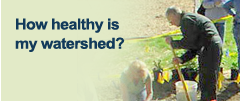
Tookany/Tacony-Frankford
Learn about the Tookany/Tacony-Frankford Watershed, your community's water protection efforts, and WHAT YOU CAN DO to protect your local creeks, rivers, and streams...
Prior to the European settlement in the 1600s, the Tookany/Tacony-Frankford watershed, like the rest of the area that is now Philadelphia, was inhabited by Native Americans of the Lenape tribe. Swedes and Finns traveling up the Delaware River were the first European inhabitants of the Tacony Creek Valley, while Germans fleeing religious persecution settled in the western portion of the watershed in what is now Germantown. In 1664, the land that is now southeastern Pennsylvania was surrendered to the English by the Dutch. In 1681, King Charles II of England granted William Penn 40,000 acres of land in the Delaware Valley as repayment for a debt owed to Penn’s father. The entire Tookany/Tacony-Frankford watershed lies within the area of this land grant. With the establishment of Penn’s colony, English settlers flocked to the region, establishing homesteads, plantations and towns.
The Tacony Creek and surrounding valley was primarily developed as an area of agriculture and milling operations, and became a center for industrial operations during the late eighteenth and early nineteenth centuries. Expansion of the city in the late 1800s converted farmland into residential neighborhoods, though active agriculture persisted in the upper watershed until the early 1900s. High-density housing characterizes the development of the area after the 1940s.
Watershed Facts
Drinking Water
The Tookany/Tacony-Frankford Watershed drains into the Delaware River, which is a source of drinking water for the City of Philadelphia.



